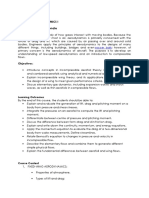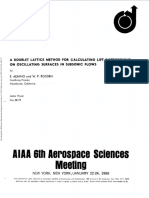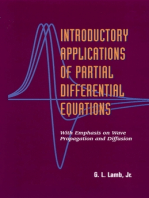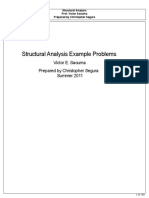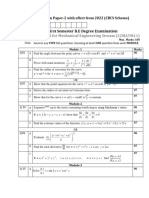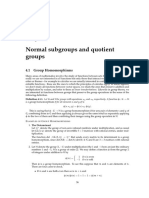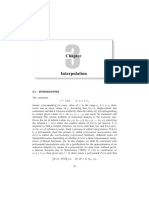Mathcad - Solution of ODEs
Uploaded by
Nguyễn Sơn LâmMathcad - Solution of ODEs
Uploaded by
Nguyễn Sơn LâmMathcad Tutorial on Solution of Ordinary Differential Equations
Vibration of a Mass-Spring-Damper System
d2 d
m x c x k x = f ( t) = sin ( 5 t)
2
dt dt
tf 40 m 1 c 0.3 k 4 ω 5
Given
d2 d
m x ( t) c x ( t) k x ( t) = sin ( ω t)
2
dt dt
x ( 0) = 0.1 x' ( 0) = 0.05
x Odesolve t tf
0.2
0.1
x ( t) 0
0.1
0.2
0 10 20 30 40
t
Other Solvers can as well be used such as
Adams, rkfixed, Rkadapt, Bulstoer, Radau
ODEs should be first order
d
Let x = y1 x ( t) = y2
dt
d
y1 ( t) = y2
dt
d 1
y2 ( t) = sin ( ω t) c y2 ( t) k y1 ( t)
dt m
Middle East Technical University, METU, Ankara/TURKEY 1 Dr. Ender CİĞEROĞLU
Mathcad Tutorial on Solution of Ordinary Differential Equations
0.1 x ( 0) = y1 ( 0)
Initial Conditions IC
0.05 x' ( 0) = y2 ( 0)
y1
Set of ODEs
D ( t y) 1
sin ( ω t) c y1 k y0
m
ts 0 tf 40 NN 500 The integer number of discretization intervals
(NN-1) used to interpolate the solution function.
S Adams IC ts tf NN D
X S1 T S0 X' S2 t ts ts 0.01 tf
0.2
0.1
X
0
x ( t)
0.1
0.2
0 10 20 30 40
T t
0.2
0.1
X
0
x ( t)
0.1
0.2
0 1 2 3 4 5
T t
Middle East Technical University, METU, Ankara/TURKEY 2 Dr. Ender CİĞEROĞLU
Mathcad Tutorial on Solution of Ordinary Differential Equations
For Stiff Problems the Following Solvers can be Used
BDF, Radau, Stiffb, Stiffr
AdamsBDF : is a hybrid solver. It uses Adams for non-stiff problems and BDF for
stiff problems. It automatically determines whether a system is stiff or
non-stiff.
d f ( t)
f ( t) = k u ( t) atanh
d 1
Friction element given below can be represented by
dt dt α μ N
where f(t) is the friction force and u(t) is the input motion (x) to the friction element.
NN 1000
k 103 μ 1 N 600 u ( t) 1 sin ( t) α 104 Nn 103
d π f
F ( t f ) k u ( t) tan
1
t0 0 f0 0 t1 15
dt α 2 μ N
d π f
D ( t f ) k u ( t) tan
1
IC 0 ts 0 tf 15
dt α 2 μ N
S rkfixed IC ts tf NN D
S2 BDF IC ts tf NN D
Y1 S1 T1 S0 Y2 S21 T2 S20
Middle East Technical University, METU, Ankara/TURKEY 3 Dr. Ender CİĞEROĞLU
Mathcad Tutorial on Solution of Ordinary Differential Equations
3
110
Non-stiff Solver
Stiff Solver
Force
0 IC
1103
0 5 10 15
Time
3
110
Non-stiff Solver
Stiff Solver
Force
0 IC
3
110
1 0.5 0 0.5 1
Displacement
As can be seen from the solutions, the non-stiff solver "rkfixed" cannot detect the stick slip
transitions correctly. Therefore, one should use a stiff solver such as "BDF" in order to
obtain the correct solution of a stiff problem. For stiff problems, non-stiff solvers require
very small time steps which are not practical in most situations.
Middle East Technical University, METU, Ankara/TURKEY 4 Dr. Ender CİĞEROĞLU
You might also like
- Unsteady Aerodynamics Assignment Expansion Waves in A Shock Tube100% (1)Unsteady Aerodynamics Assignment Expansion Waves in A Shock Tube10 pages
- Strang (1968) - On The Construction and Comparison of Difference Schemes100% (1)Strang (1968) - On The Construction and Comparison of Difference Schemes13 pages
- CEI Extraction of Boundary Layer Characteristics From Fluent ResultsNo ratings yetCEI Extraction of Boundary Layer Characteristics From Fluent Results30 pages
- Liquid: Evaporation Rates of Hydrocarbon Spills Land and WaterNo ratings yetLiquid: Evaporation Rates of Hydrocarbon Spills Land and Water6 pages
- EA 311 - Aerodynamics I - Course OutlineNo ratings yetEA 311 - Aerodynamics I - Course Outline3 pages
- Fluid Dynamics Theoretical and Computational Approaches, Second Edition by Z.U.a. WarsiNo ratings yetFluid Dynamics Theoretical and Computational Approaches, Second Edition by Z.U.a. Warsi748 pages
- Instant Download Thermal Engineering Studies With Excel Mathcad and Internet 1st Edition Valery Ochkov PDF All Chapter100% (4)Instant Download Thermal Engineering Studies With Excel Mathcad and Internet 1st Edition Valery Ochkov PDF All Chapter62 pages
- Von Rosemberg Method For Numerical Solution of Differential EquationNo ratings yetVon Rosemberg Method For Numerical Solution of Differential Equation77 pages
- Computational Fluid Dynamics - Docx Objective QuestionsNo ratings yetComputational Fluid Dynamics - Docx Objective Questions5 pages
- Poiseuille Flow: An Internet Book On Fluid DynamicsNo ratings yetPoiseuille Flow: An Internet Book On Fluid Dynamics4 pages
- Conservation Laws: Closed System Control VolumesNo ratings yetConservation Laws: Closed System Control Volumes34 pages
- Numerical Fluid Mechanics: Chungen Yin, PH.DNo ratings yetNumerical Fluid Mechanics: Chungen Yin, PH.D28 pages
- Full Elementary Aerodynamics Course by MITNo ratings yetFull Elementary Aerodynamics Course by MIT158 pages
- Implement Multiphase Chalmers Student ProjectNo ratings yetImplement Multiphase Chalmers Student Project23 pages
- Programming Turbulence Models in Fortran: Eirik Helno HerøNo ratings yetProgramming Turbulence Models in Fortran: Eirik Helno Herø67 pages
- CH 6 Differential Analysis of Fluid Flow Part IINo ratings yetCH 6 Differential Analysis of Fluid Flow Part II100 pages
- Two Dimensional Oblique Shocks Expansion FlowsNo ratings yetTwo Dimensional Oblique Shocks Expansion Flows18 pages
- Fluid Mechanics Chapter 1-Basic ConceptsNo ratings yetFluid Mechanics Chapter 1-Basic Concepts29 pages
- ENO SysteENO and WENO Schemes For Hyperbolic Conservation LawsNo ratings yetENO SysteENO and WENO Schemes For Hyperbolic Conservation Laws41 pages
- Introduction To Airframe Systems II-Student'sNo ratings yetIntroduction To Airframe Systems II-Student's38 pages
- Principles of helicopter aerodynamics; J. Gordon LeishmanNo ratings yetPrinciples of helicopter aerodynamics; J. Gordon Leishman539 pages
- Note On A Class of Solutions of The Navier-Stokes Equations Representing Steady Rotationally-Symmetric FlowNo ratings yetNote On A Class of Solutions of The Navier-Stokes Equations Representing Steady Rotationally-Symmetric Flow13 pages
- 15-Hydraulic Turbines-New031211 (Compatibility Mode) PDF50% (2)15-Hydraulic Turbines-New031211 (Compatibility Mode) PDF86 pages
- Steady-State and Unsteady-State Flow of Non':'Newtonian Fluids Through Porous MediaNo ratings yetSteady-State and Unsteady-State Flow of Non':'Newtonian Fluids Through Porous Media9 pages
- In-situ Characterization of Heterogeneous CatalystsFrom EverandIn-situ Characterization of Heterogeneous CatalystsJosé A. RodriguezNo ratings yet
- Introductory Applications of Partial Differential Equations: With Emphasis on Wave Propagation and DiffusionFrom EverandIntroductory Applications of Partial Differential Equations: With Emphasis on Wave Propagation and DiffusionNo ratings yet
- Kudryavtsev 2019 IOP Conf. Ser. Mater. Sci. Eng. 698 022081No ratings yetKudryavtsev 2019 IOP Conf. Ser. Mater. Sci. Eng. 698 0220817 pages
- Use of Mathcad in Computing Beam Deflection by Conjugate Beam MethodNo ratings yetUse of Mathcad in Computing Beam Deflection by Conjugate Beam Method16 pages
- Generalized Force Method On The Example of Plane Geometrically Nonlinear ProblemNo ratings yetGeneralized Force Method On The Example of Plane Geometrically Nonlinear Problem7 pages
- Linear Differential Equations With Mathcad: Conference PaperNo ratings yetLinear Differential Equations With Mathcad: Conference Paper19 pages
- Advanced Digital Signal Processing: Lecture 4: The Discrete Fourier Transform ... III The Fast Fourier Transform (FFT)No ratings yetAdvanced Digital Signal Processing: Lecture 4: The Discrete Fourier Transform ... III The Fast Fourier Transform (FFT)38 pages
- Solutions To Problems in Merzbacher Quantum Mechanics 3rd Ed-Reid-P5990% (10)Solutions To Problems in Merzbacher Quantum Mechanics 3rd Ed-Reid-P5959 pages
- Fastrack Objective Mathematics by Rajesh Varma100% (1)Fastrack Objective Mathematics by Rajesh Varma1,727 pages
- Bargmann, On A Hilbert Space of Analytic Functions and An Associated Integral TransformNo ratings yetBargmann, On A Hilbert Space of Analytic Functions and An Associated Integral Transform101 pages
- Linear Equation in One Variable Part 1 Assignment100% (1)Linear Equation in One Variable Part 1 Assignment3 pages
- First Order PDE Questions and Answers - SanfoundryNo ratings yetFirst Order PDE Questions and Answers - Sanfoundry6 pages
- X X X X X X X X X X X X X X: Sec Tan Sin Tan Sin CSC Cot Cos CSC Cot Cot Cos Tan Sec100% (1)X X X X X X X X X X X X X X: Sec Tan Sin Tan Sin CSC Cot Cos CSC Cot Cot Cos Tan Sec7 pages
- RS-Aggarwal-Class-12-Maths-Chapter-4.-Inverse-Trigonometric-Functions100% (1)RS-Aggarwal-Class-12-Maths-Chapter-4.-Inverse-Trigonometric-Functions73 pages
- Consider The Bases B (U1, U2, U3) and B' (U'1, U'2, U'3) - QuizletNo ratings yetConsider The Bases B (U1, U2, U3) and B' (U'1, U'2, U'3) - Quizlet8 pages
- (Translations of Mathematical Monographs) A. N. Andrianov and v. G. Zhuravlev - Modular Forms and Hecke Operators (1995, American Mathematical Society)No ratings yet(Translations of Mathematical Monographs) A. N. Andrianov and v. G. Zhuravlev - Modular Forms and Hecke Operators (1995, American Mathematical Society)347 pages
- Normal Subgroups and Quotient Groups: 4.1 Group HomomorphismsNo ratings yetNormal Subgroups and Quotient Groups: 4.1 Group Homomorphisms3 pages
- Assess Your Understanding: Are You Prepared?No ratings yetAssess Your Understanding: Are You Prepared?5 pages
- Unsteady Aerodynamics Assignment Expansion Waves in A Shock TubeUnsteady Aerodynamics Assignment Expansion Waves in A Shock Tube
- Strang (1968) - On The Construction and Comparison of Difference SchemesStrang (1968) - On The Construction and Comparison of Difference Schemes
- CEI Extraction of Boundary Layer Characteristics From Fluent ResultsCEI Extraction of Boundary Layer Characteristics From Fluent Results
- Liquid: Evaporation Rates of Hydrocarbon Spills Land and WaterLiquid: Evaporation Rates of Hydrocarbon Spills Land and Water
- Fluid Dynamics Theoretical and Computational Approaches, Second Edition by Z.U.a. WarsiFluid Dynamics Theoretical and Computational Approaches, Second Edition by Z.U.a. Warsi
- Instant Download Thermal Engineering Studies With Excel Mathcad and Internet 1st Edition Valery Ochkov PDF All ChapterInstant Download Thermal Engineering Studies With Excel Mathcad and Internet 1st Edition Valery Ochkov PDF All Chapter
- Von Rosemberg Method For Numerical Solution of Differential EquationVon Rosemberg Method For Numerical Solution of Differential Equation
- Computational Fluid Dynamics - Docx Objective QuestionsComputational Fluid Dynamics - Docx Objective Questions
- Poiseuille Flow: An Internet Book On Fluid DynamicsPoiseuille Flow: An Internet Book On Fluid Dynamics
- Programming Turbulence Models in Fortran: Eirik Helno HerøProgramming Turbulence Models in Fortran: Eirik Helno Herø
- ENO SysteENO and WENO Schemes For Hyperbolic Conservation LawsENO SysteENO and WENO Schemes For Hyperbolic Conservation Laws
- Principles of helicopter aerodynamics; J. Gordon LeishmanPrinciples of helicopter aerodynamics; J. Gordon Leishman
- Note On A Class of Solutions of The Navier-Stokes Equations Representing Steady Rotationally-Symmetric FlowNote On A Class of Solutions of The Navier-Stokes Equations Representing Steady Rotationally-Symmetric Flow
- 15-Hydraulic Turbines-New031211 (Compatibility Mode) PDF15-Hydraulic Turbines-New031211 (Compatibility Mode) PDF
- Steady-State and Unsteady-State Flow of Non':'Newtonian Fluids Through Porous MediaSteady-State and Unsteady-State Flow of Non':'Newtonian Fluids Through Porous Media
- In-situ Characterization of Heterogeneous CatalystsFrom EverandIn-situ Characterization of Heterogeneous Catalysts
- Introductory Applications of Partial Differential Equations: With Emphasis on Wave Propagation and DiffusionFrom EverandIntroductory Applications of Partial Differential Equations: With Emphasis on Wave Propagation and Diffusion
- Essentials in Nanoscience and NanotechnologyFrom EverandEssentials in Nanoscience and Nanotechnology
- Kudryavtsev 2019 IOP Conf. Ser. Mater. Sci. Eng. 698 022081Kudryavtsev 2019 IOP Conf. Ser. Mater. Sci. Eng. 698 022081
- Use of Mathcad in Computing Beam Deflection by Conjugate Beam MethodUse of Mathcad in Computing Beam Deflection by Conjugate Beam Method
- Generalized Force Method On The Example of Plane Geometrically Nonlinear ProblemGeneralized Force Method On The Example of Plane Geometrically Nonlinear Problem
- Linear Differential Equations With Mathcad: Conference PaperLinear Differential Equations With Mathcad: Conference Paper
- Advanced Digital Signal Processing: Lecture 4: The Discrete Fourier Transform ... III The Fast Fourier Transform (FFT)Advanced Digital Signal Processing: Lecture 4: The Discrete Fourier Transform ... III The Fast Fourier Transform (FFT)
- Solutions To Problems in Merzbacher Quantum Mechanics 3rd Ed-Reid-P59Solutions To Problems in Merzbacher Quantum Mechanics 3rd Ed-Reid-P59
- Bargmann, On A Hilbert Space of Analytic Functions and An Associated Integral TransformBargmann, On A Hilbert Space of Analytic Functions and An Associated Integral Transform
- First Order PDE Questions and Answers - SanfoundryFirst Order PDE Questions and Answers - Sanfoundry
- X X X X X X X X X X X X X X: Sec Tan Sin Tan Sin CSC Cot Cos CSC Cot Cot Cos Tan SecX X X X X X X X X X X X X X: Sec Tan Sin Tan Sin CSC Cot Cos CSC Cot Cot Cos Tan Sec
- RS-Aggarwal-Class-12-Maths-Chapter-4.-Inverse-Trigonometric-FunctionsRS-Aggarwal-Class-12-Maths-Chapter-4.-Inverse-Trigonometric-Functions
- Consider The Bases B (U1, U2, U3) and B' (U'1, U'2, U'3) - QuizletConsider The Bases B (U1, U2, U3) and B' (U'1, U'2, U'3) - Quizlet
- (Translations of Mathematical Monographs) A. N. Andrianov and v. G. Zhuravlev - Modular Forms and Hecke Operators (1995, American Mathematical Society)(Translations of Mathematical Monographs) A. N. Andrianov and v. G. Zhuravlev - Modular Forms and Hecke Operators (1995, American Mathematical Society)
- Normal Subgroups and Quotient Groups: 4.1 Group HomomorphismsNormal Subgroups and Quotient Groups: 4.1 Group Homomorphisms









